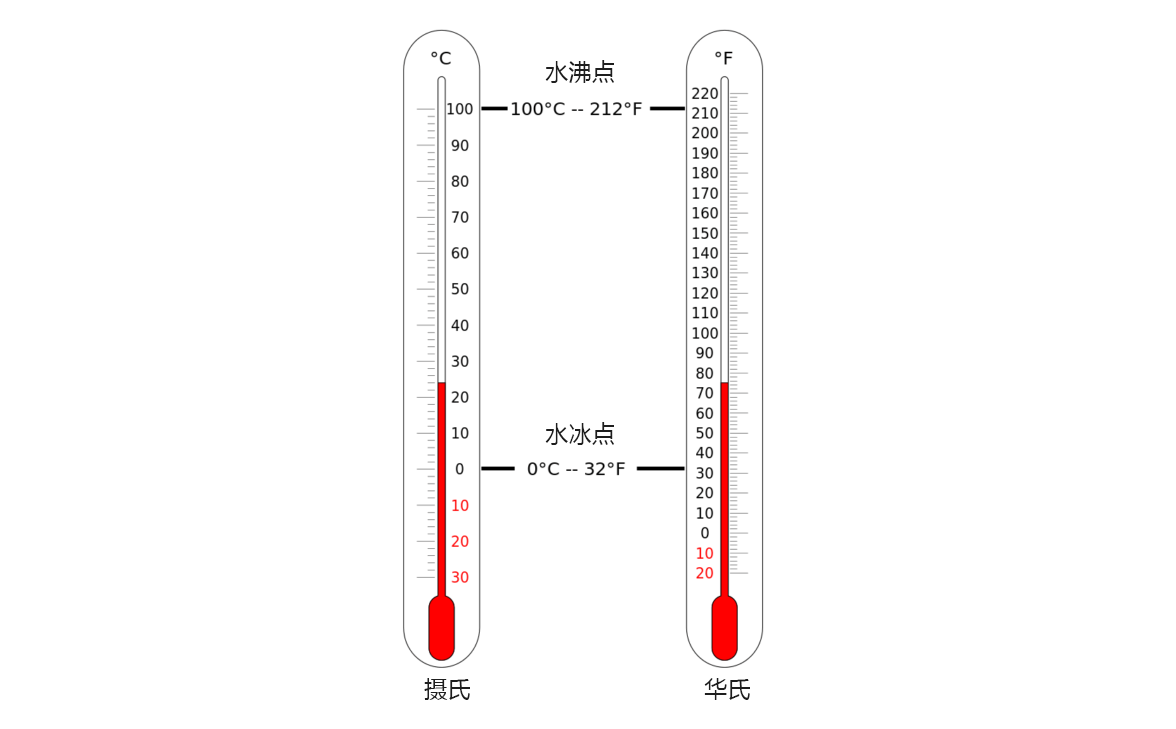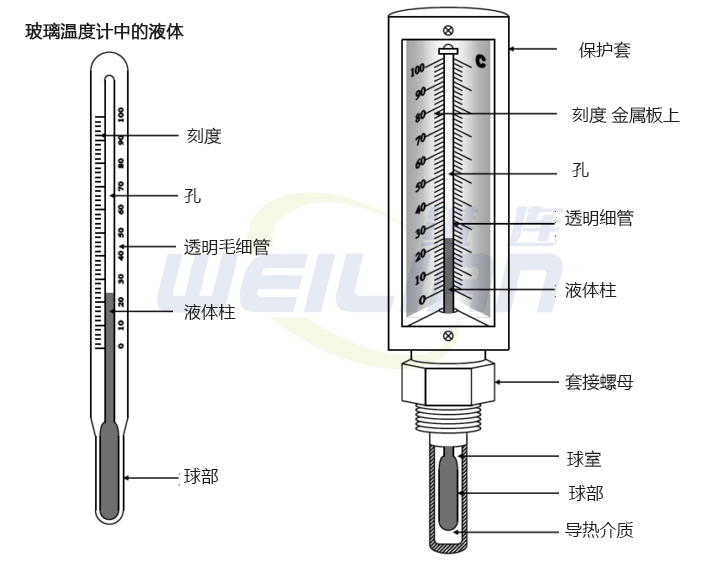
Principle of liquid glass thermometer
The liquid in the glass thermometer is the most commonly used temperature measuring equipment, which has low manufacturing cost and is easy to use.
The liquid in a glass thermometer has a glass bulb connected to a sealed glass tube (also called a rod or capillary).
A very thin opening, called a hole, exists at the ball and extends down to the center of the tube.
The spherical chamber is usually filled with mercury or red alcohol, which can expand freely and rise into the tube when the temperature rises, and contract and move downward when the temperature drops.
In liquid in glass thermometers (LIGs), the thermistor is the liquid contained in the scale glass housing.
The principle used to measure temperature is the principle of apparent thermal expansion of liquids.
A typical liquid in glass thermometer is shown in the figure below.

The background of the glass tube is covered with white enamel. A magnifying glass is formed on the front of the glass tube to magnify the liquid column for reading the temperature.
In the following figure (left), an all glass thermometer is depicted with its scale engraved on the rod.
The liquid in the glass thermometer is fragile. For industrial use, the thermometer is installed in the protective housing, and the scale is engraved on a separate plate that is part of the protective housing.
The industrial thermometer is shown in the figure below.

It mainly includes:
● A spherical part, used as a container for functional liquid, which can easily expand or shrink the capacity.
● Stem, "a glass tube containing a small capillary connected to the ball and expanded at the bottom into a ball partially filled with working fluid".
● The temperature scale basically preset or printed on the valve stem is used to display the temperature reading.
● Reference point, i.e. calibration point, the most common is freezing point.
● A working fluid, usually mercury or alcohol.
● An inert gas, mainly argon or nitrogen, is filled in the thermometer above mercury to reduce its volatilization.
Liquids used in glass thermometers

benefit
The following are the main advantages associated with using liquid in glass thermometers:
● They are relatively cheaper than other temperature measuring equipment.
● They are easy to use.
● Unlike electronic thermometers, they do not require power or batteries to charge.
● They can often be used in areas with power problems.
● They provide very good repeatability and their calibration is not affected.
limit
The use of liquid in glass thermometers also includes the following limitations:
● They are not considered suitable for applications involving very high or very low temperatures.
● They cannot be used in areas where high precision results are required.
● They are very fragile and fragile compared to electronic thermometers. Therefore, care must be taken when handling them, as they are likely to break.
● In addition, they cannot provide digital and automated results. Therefore, their use is limited to areas where manual readings are sufficient, such as household thermometers.
● "The temperature reading shall be recorded immediately after taking it out, because the glass thermometer will be affected by the ambient temperature, heat generated by the hand holding it, cleaning, etc. The temperature shall be recorded, because the glass thermometer does not provide the recall temperature of the measured value."
● Bright vision is required to read temperature through liquid in glass thermometer.
● Liquid elements contained in glass thermometers may be harmful or risky to health due to potential chemical leakage.
● These thermometers display temperatures in degrees Celsius or Fahrenheit. Therefore, if the temperature needs to be read in some other proportion, a temperature conversion is required.
Type of liquid in glass thermometer
There are two main types of liquid in glass thermometers, as follows:
1 Mercury thermometer
2 Alcohol thermometer
Mercury thermometer
This type of thermometer was developed by a German physicist named Daniel Gabriel Fahrenheit.
It consists of liquid mercury filled in glass tubes. On the main body of the glass tube, a calibration mark is provided to facilitate reading the temperature.
A bulb is formed at one end of the thermometer, which contains the largest part of mercury.
The expansion and contraction of the mercury size are further increased in the extreme pores of the glass tube. It helps to improve the sensitivity of the thermometer.
Usually, the area above mercury is filled with inert gases, such as nitrogen. However, the area can also be evacuated.
Various types of mercury in glass thermometers can be used. "The highest thermometer is a unique mercury thermometer, whose function is to contract the neck near the bulb.
As the temperature rises, the expansion force forces mercury upward through the contraction. When the temperature decreases, the mercury column will break at the contraction point and cannot return to the ball, so it will remain stationary in the tube. "
With the help of the highest thermometer, one can measure the highest temperature in a predetermined time span.
Resetting the highest thermometer is a very simple process, which requires only a quick swing of the thermometer.
The freezing point of mercury is – 38.83 ° C, at which time it will solidify. However, it will not cause expansion during solidification, so there is no danger of thermometer tube glass breaking.
Whenever the temperature rises, the nitrogen that fills the glass tube above the mercury usually comes down from the column and gets stuck there.
This whole action may affect the function of the thermometer. To avoid this difficulty, when the temperature drops to – 37 ° C, you must try to put the mercury thermometer inside.
In areas where the upper temperature limit is – 38.83 ° C, mercury thallium alloy thermometers with a freezing point of – 61.1 ° C can be used.
Alcohol thermometer
Alcohol thermometers are replacing mercury thermometers in many applications.
They use alcohol as the liquid in glass tubes. The temperature range of alcohol thermometer is from 115 ° C to 785 ° C. The former is the freezing point of alcohol, and the latter is the boiling point of alcohol.
A typical thermometer used to obtain ambient temperature readings requires a temperature range of - 20 ° F to 120 ° F, i.e. - 30 ° C to 50 ° C.
Alcohol is a volatile substance, which may cause chromatographic column separation in thermometer due to mechanical impact.
The column can then be reconnected by dropping the thermometer on a wooden surface wrapped in a large amount of paper. "Hold the thermometer in a vertical position, with the bulb end facing down, 4 to 6 inches from the paper covered wood surface, and set it down.
When the bulb of the thermometer touches the paper, hold the thermometer with the other hand to prevent damage. A small amount of alcohol may adhere to the capillary portion above the alcohol column. "
The hot part of the thermometer can be heated under an incandescent lamp, which will bring alcohol to the column.
The thermometer can also be installed vertically overnight, which will allow the alcohol to flow back to the chromatographic column.
This thermometer should not be used with a separate fluid column, as it usually results in incorrect temperature measurements.

